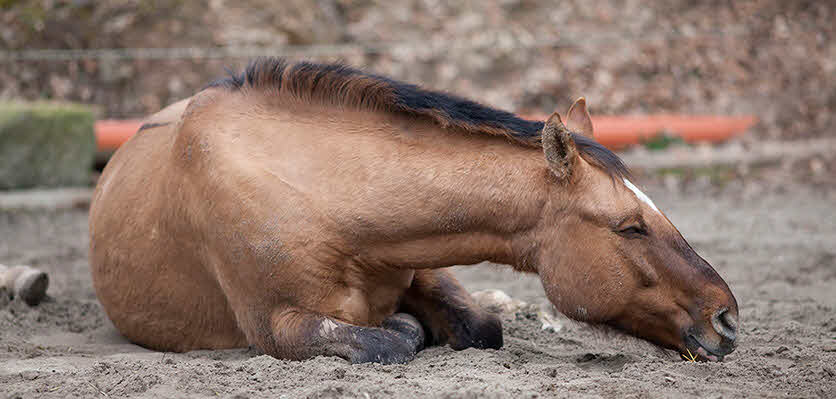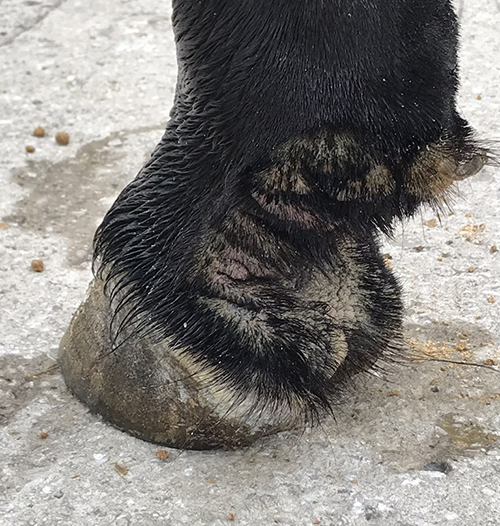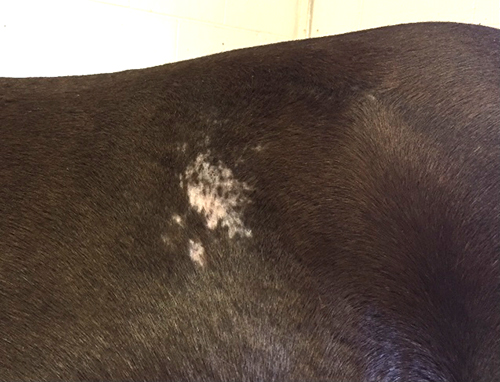Colic

- Colic is a collection of clinical signs shown by a horse that indicate abdominal discomfort.
- Changes in management, especially if not made gradually, can precipitate episodes of colic.
- At this time of year, horses undergo a significant management change, coming in from pasture to spend prolonged periods of time in their stable.
- Therefore, we frequently see an increased incidence of colic cases.
- Fortunately, the vast majority of cases can be managed medically and although arguably, spasmodic colic remains the most prevalent form of colic that we see, impaction colic occurs at an increased frequency.
Impactions
- Impactions generally occur following the accumulation of food material, which subsequently dehydrates (dries out), in a horse’s colon.
- The colon’s pelvic flexure is the most common site for this to occur. The pelvic flexure is a part of the large colon which turns 180 degrees on itself and naturally narrows. The reduced speed of food material passing through this area means it is more susceptible than other areas to blockage.
- Other risk factors for impaction development include reduced grazing and increased hay/haylage in the diet, reduced exercise due to increased time spend confined in the stable, reduced water intake during cold/frosty periods and straw ingestion (if bedded on straw) to name but a few.
- Clinical signs of impaction colic include passing reduced amounts of, drier than normal, faeces over the preceding 48-72 hours to eventually passing no droppings at all, reduced appetite and signs of colic which vary in severity but can be relatively mild.
- Veterinary examination may reveal a normal/mildly increased heart rate, dry gums and prolonged skin tent. Gut sounds are generally reduced. Impactions of the pelvic flexure are confirmed on rectal examination. They are usually ‘doughy’ in consistency and sit in the left, lower abdomen.
- Treatment, similar to other forms of colic, includes the administration of pain relief and smooth muscle relaxants. In addition, the blocked food material requires rehydration. The most effective way to achieve this is by regularly administering an electrolyte solution via stomach tube. The administered fluid stimulates colon contraction and the fluid passes through the gastrointestinal tract to rehydrate the impaction stimulating it’s passage through the remainder of the gastrointestinal tract prior to evacuation from the body. For the majority of patients, monitoring and treatment of the impaction is carried out most effectively at our equine clinic. Depending on severity, impactions can take varying periods of time to resolve from 24-48 hours to 5 days. Food is withheld until the impaction has cleared and is gradually reintroduced starting with walks to grass and ‘sloppy’ bucket feeds.
Tips for preventing impaction colic (and colic in general)!
- Make dietary changes slowly over a 2-week period of time.
- Avoid straw bedding if you are concerned your horse or pony eats it.
- Try to maintain exercise. A walk around the yard is better than standing still in a stable.
- Ensure a ready access to fresh water- break ice regularly when temperatures drop- a tennis ball/apple placed in water may help reduce freezing.
- Ensure your horse is drinking. Water intake can be increased by adding water to your horse’s feeds. Providing a salt lick will also stimulate thirst.
Mud Fever

- Mud fever is an infection of the skin usually affecting the pastern.
- The bacteria implicated (Dermatophilus congolensis), gains entry to the skin most commonly, following prolonged periods of wetting/standing in mud.
- The resulting dermatitis is characterised by hair loss and crusting. Hair comes away in tufts bound by a scab/crust (known as paint-brush lesions).
- Minor cases may present as just a few scabs; however, cellulitis (subcutaneous skin infection) can ensue.
- Treatment is based on removing your horse from the wet/muddy conditions. Mild cases can be managed topically using a combination of anti-bacterial and steroid based creams. The affected area may also be clipped and cleaned using a warm dilute chlorhexidine solution. Different vets vary in their recommendations as to frequency of cleaning so please follow your vet’s recommendations. In moderate to severe cases, sedation may be required to examine, clip and clean the area in the first instance. In cases with secondary cellulitis, antibiotics and anti-inflammatories are also required.
Rain scald

- Rain scald is similar to mud fever, in that it is caused by the same bacterium following prolonged skin wetting, but affects the horse’s topline.
- Treatment mirrors that of mud fever.
